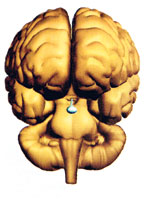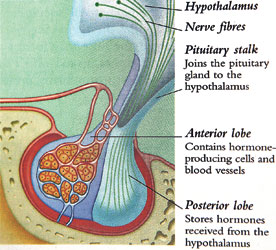We have all heard about giants in stories...in some they are depicted as being big and scary and in others as gentle beings. In some they chase little boys down bean stalks and in others help to save the world. Even in our history books there are stories involving exceptionally large humans – giants. They have helped to win wars and if nothing else made reading history books more interesting.
Although I do not wish to take the enjoyment out of these stories, the reason for the existence of giants can be explained by a condition called gigantism, which is caused by a dysfunctioning gland in the brain.
The very important pituitary gland in the brain is involved in producing substances or hormones, as they are called medically, in the right amounts for our bodies to function normally. Anatomically, the pituitary gland is placed within the skull between the eyes and behind the nose. It is attached to other brain tissue by the pituitary stalk. It receives information from the brain via another organ called the hypothalamus to which it is connected.
 |
| Site of the pituitary gland |
| The pituitary gland (small green structure in picture) is suspended by a stalk from the underside of the brain |
The abnormal growth of the pituitary gland can cause over-activity or under-activity of the gland, thereby altering the amount of the hormones it secretes. This gives rise to many conditions, one of them being gigantism. The hormone involved in this condition is called 'growth hormone'.
The over-production of the growth hormone in a child before normal growth is complete can give rise to giants. If the same hormone is produced in inadequate amounts it gives rise to persons of short stature or dwarfism.
If the gland dysfunctions after growth has taken place, which is in adults, patients may present with some alarming symptoms – this condition is called acromegaly.
The first thing to understand clearly is that the overgrowth of the pituitary gland is benign in nature. The growth of the gland is known as a pituitary adenoma.
The increase in the size of the gland itself can cause direct pressure on other regions of the brain such as the path affecting vision, therefore a patient may present with visual deterioration. The enlargement of the gland may also cause other hormones produced by the gland to be under or over-secreted.
These may give rise to a multitude of symptoms such as changes in libido, altered menstrual cycle, abnormal production of breast milk in women and the under-functioning of reproductive organs. Tiredness and lethargy are also common presentations.
Gigantism is easily recognisable as suggested by the name. Patients show exaggerated vertical growth and continue growing abnormally. All limbs and structures are in proportion.
 |
| Inside the pituitary |
| The two inner lobes of the pituitary gland release a range of hormones that affect many parts of the body |
In acromegaly, the patient's family and friends may notice a difference before he/she does. The individual's hands and feet begin to grow and they may note an increase in shoe size.
The face changes, the facial features become coarse. The tongue grows larger and there is swelling within the structures of the throat and sinuses and the voice may change in character.
Their partner may notice that they have begun to snore heavily. Hormonal changes may also cause further symptoms:
- sweating
- oily skin
- increased body hair
- high blood pressure
- abnormal sugar levels in the blood
- increased risks of gallstones
- swelling of the thyroid gland
The individual may also have growths such as polyps in the intestines due to the increase in all tissues. They may also have tingling and numbness in the hands, a condition called carpel tunnel syndrome.
Diagnosis
If these features are noted, go to your family doctor who will refer you to an endocrinologist, who is a specialist doctor who deals with problems with hormones. The endocrinologist will then order a number of investigations such as blood tests to assess the levels of the hormones, urine tests and MRI scans to identify a pituitary adenoma, to come to the right diagnosis. All this will take some time. Your vision will also be assessed and documented. You must inform the doctor if there is a sudden deterioration of your vision.
Treatment
The first line of treatment is surgery to remove the overgrowth of the pituitary gland and the patient will be referred to a neurosurgeon for a procedure called 'transspenoidal endoscopic or microscopic surgery'.
This essentially involves gaining access to the pituitary gland through one of the nostrils and using a camera to assist in the surgery. If the surgery is more complex and the adenoma large, it may require more extensive brain surgery. Surgery may be followed by medical treatment. Sometimes radiotherapy (X-ray beams) may also be used to slow down the growth of the adenoma.
Surgery is generally very successful and with the aid of medication patients return to their normal day-to-day activities. It is essential to follow-up surgery with regular blood tests and assessments of vision. |


